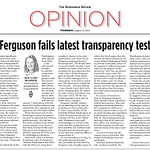Reading WAC 194-50 defining the Clean Buildings Act makes me think of a favorite history prof's description of the cyclical nature of Chinese history, wherein one warlord would overpower the others, unify the country, declare himself emperor, and set up a Confucian civil service for administration. The power of the civil service would rise, with bureaucrats tying the population in knots until the countryside was fed up. At which point a new warlord rode in from the hinterlands and lopped off a few heads to cut the administration down to size.
There won’t be any warlords riding in to save us, but with a little effort we might get sensible legislating back in Olympia, Washington if the one party monopoly on power can be broken at the ballot box.
REFERENCES with excerpts and <commentary>
2023 Legislative Report: https://deptofcommerce.app.box.com/s/tmxletsmxoml5n4zky187kpj9qlotk7p
. . .create an incentive program . . . <as if rising fuel prices wasn’t enough of an incentive>
Commerce was charged with conducting rulemaking to establish administrative rules for the law, creating a database of covered buildings in the state, notifying building owners of the requirements of the law, establishing an incentive program for early adopters of the standard and providing customer support to the industry. <instead of supporting commerce, the department is now tangling it in red tape>
Figure 1. Number of possible covered Tier 1 buildings by county
<Spokane has 666. Not an auspicious number.>
History of the Act: https://deptofcommerce.app.box.com/s/5x2cbvn1l8bi8mvv3ve9y41wvp3zjz91
With the life of a building spanning at least 50-100 years, retrofitting our existing buildings to use less energy is the most cost-efficient way to reduce greenhouse gas emissions significantly. To meaningfully reduce building emissions, we need more robust energy use standards. The 2019 Clean Buildings Act created energy performance standards for existing covered buildings larger than 50,000 square feet. Mandatory compliance begins in 2026. The 2022 expansion bill added a new second tier of buildings larger than 20,000 square feet, including multifamily buildings . . .
To meaningfully reduce these emissions, the legislature passed clean buildings laws in 2019 (HB 1257) and 2022 (SB 5722) to:
1. Create an energy performance standard for non-residential buildings larger than 50,000 square feet;
and
2. Require energy management planning, operations and maintenance and tracking energy use over time for non-residential buildings larger than 20,000 square feet and multifamily buildings over 50,000 square feet.
Clean Buildings notification letter template: Issued by Dept of Commerce based on data gleaned from each county assessor’s records.
Clean Buildings Performance Standard FAQ:
https://deptofcommerce.app.box.com/s/gtgnjoolbj0bshdzdr7482phqo7phnda
Compliance deadlines
Tier 1 covered buildings reporting schedule:
June 1, 2026 - More than 220,000 sq. ft. <Lewis & Clark>
June 1, 2027 - More than 90,000 sq. ft. but less than 220,001 sq. ft <Sacajawea MS>
June 1, 2028 - More than 50,000 sq. ft. but less than 90,001 sq. ft <Mullan Rd Elem>
Tier 2 covered buildings reporting schedule:
July 1, 2027 - More than 20,000 sq. ft. but less than 50,001 sq. ft. and All Multifamily residential buildings more than 20,000 sq. ft. <Typ. apt. bldg. w/ 20 or more units>
FAQ: What is the list of exemptions for the Clean Buildings Performance Standards?
The complete list of exemptions and details can be found in RCW 19.27A.210(7)(c) and Section Z4.1 of the Standard. Learn more about each exemption in guidance documents 21(a)-(g) in the CBPS Document Library. Exemptions include:
No certificate of occupancy
At least 50% of conditioned floor area is unoccupied
Less than 50,000 square feet of conditioned space
More than 50% of floor area designated as Factory Group F or High Hazard Group H by the Washington state edition of the International Building Code (WA IBC)
Agricultural structures
Building is pending demolition
Financial hardship <not financial hardship as the building owner defines it but as the state defines it; the two concepts may not be congruent>














Share this post